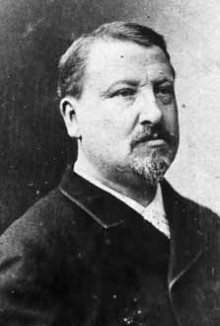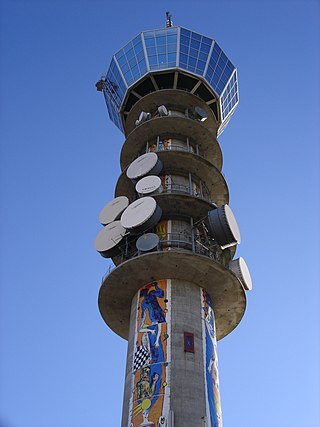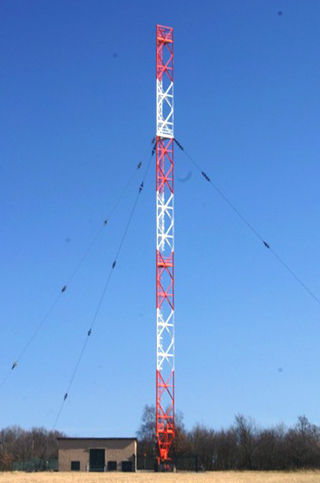
French radio stations are licensed and regulated by the CSA, and public radio services are provided by Radio France.

French radio stations are licensed and regulated by the CSA, and public radio services are provided by Radio France.
The history of radio in France began in 1897 when Eugène Adrien Ducretet successfully transmitted radio messages between two Paris landmarks. [1] However, radio only became fully developed during the interwar period, when the Daladier government brought broadcasting under their centralized control in 1938. [1]
During the First World War, General Gustave-Auguste Ferrié began using the Eiffel Tower for radio transmissions. [1] Radiotechnique, founded in 1919 as a holding company for Émile Girardeau's Société française radio-électrique, began manufacturing radio sets in 1921. [2] Radio Normandie (originally Radio Fécamp), created by Fernand Le Grand, was licensed by the French government in 1926. [3] In 1931, Leonard Plugge, a British politician, founded the "International Broadcasting Company" and persuaded Le Grand to start broadcasting programs in English.
After World War II, radio in France became a public monopoly.
"Peripheral radio" were radio stations transmitting from outside France and therefore operating outside of the public monopoly. These included Europe 1, Sud Radio, Radio Monte Carlo and Radio Luxembourg. [4]
Radio Luxembourg was broadcasting on Long Wave from Luxembourg before WW2. In 1956, from Germany Sarre another "peripheral" station named Europe 1 came on the air on Long Wave, on 183 kHz. Germany's Sarre mainly was aimed at the northern half of France. In 1970 and onwards, "peripherals" would benefit from almost-national coverage due to 2000 kW transmitters. At that time, Radio Monte Carlo (RMC) started to broadcast on Long Wave at 216 kHz. From 1976, the transmitter was allowed to broadcast from France (Roumoules north of Marseille), with 1400 kW being heard in the southern half of France. Meanwhile, Sud Radio on 819 kHz was broadcasting from Andorra for the southwest with 900 kW.
In 1981, as promised by newly elected François Mitterrand,[ citation needed ] independent stations were allowed, at first with very little power and on FM only.[ citation needed ] Since 1981, the number of stations in France (public and private) has reached more than 1700. The AM band is not used in France (though it was viral before WW2).
Longwave has been abandoned by Radio France in 2018, Europe 1 in 2019, and RMC in 2020.[ clarification needed ]. Radio Luxembourg abandoned the LW on the 1st of january 2023. Sud Radio has left AM for FM, where all stations now are. DAB+ is currently being developed to accommodate more programs.

Medium wave (MW) is the part of the medium frequency (MF) radio band used mainly for AM radio broadcasting. The spectrum provides about 120 channels with more limited sound quality than FM stations on the FM broadcast band. During the daytime, reception is usually limited to more local stations, though this is dependent on the signal conditions and quality of radio receiver used. Improved signal propagation at night allows the reception of much longer distance signals. This can cause increased interference because on most channels multiple transmitters operate simultaneously worldwide. In addition, amplitude modulation (AM) is often more prone to interference by various electronic devices, especially power supplies and computers. Strong transmitters cover larger areas than on the FM broadcast band but require more energy and longer antennas. Digital modes are possible but have not reached momentum yet.

AM broadcasting is radio broadcasting using amplitude modulation (AM) transmissions. It was the first method developed for making audio radio transmissions, and is still used worldwide, primarily for medium wave transmissions, but also on the longwave and shortwave radio bands.

In radio, longwave, long wave or long-wave, and commonly abbreviated LW, refers to parts of the radio spectrum with wavelengths longer than what was originally called the medium-wave broadcasting band. The term is historic, dating from the early 20th century, when the radio spectrum was considered to consist of longwave (LW), medium-wave (MW), and short-wave (SW) radio bands. Most modern radio systems and devices use wavelengths which would then have been considered 'ultra-short'.

Radio broadcasting is the broadcasting of audio (sound), sometimes with related metadata, by radio waves to radio receivers belonging to a public audience. In terrestrial radio broadcasting the radio waves are broadcast by a land-based radio station, while in satellite radio the radio waves are broadcast by a satellite in Earth orbit. To receive the content the listener must have a broadcast radio receiver (radio). Stations are often affiliated with a radio network that provides content in a common radio format, either in broadcast syndication or simulcast, or both. Radio stations broadcast with several different types of modulation: AM radio stations transmit in AM, FM radio stations transmit in FM, which are older analog audio standards, while newer digital radio stations transmit in several digital audio standards: DAB, HD radio, DRM. Television broadcasting is a separate service that also uses radio frequencies to broadcast television (video) signals.

Pirate radio or a pirate radio station is a radio station that broadcasts without a valid license.
RTÉ Radio 1 is an Irish national radio station owned and operated by RTÉ and is the direct descendant of Dublin radio station 2RN, which began broadcasting on a regular basis on 1 January 1926.

The Office de radiodiffusion-télévision française was the national agency charged, between 1964 and 1975, with providing public radio and television in France. All programming, and especially news broadcasts, were under strict control of the national government.

RTL is a French commercial radio network owned by the RTL Group. Founded in 1933 as Radio Luxembourg, it broadcast from outside France until 1981 because only public stations had been allowed until then. It is a general-interest, news, talk and music station, broadcasting nationally in France, Francophone Belgium, and Luxembourg. Until 2022, RTL was also broadcast on long wave frequency 234 kHz from Beidweiler which could be picked up in large parts of the continent. It has a sister station called Bel RTL tailored for the French Community of Belgium. As of 2018, RTL is France's most popular radio station with an average of 6.4 million daily listeners that year.

The Roumoules transmitter is the main broadcasting facility for longwave and mediumwave broadcasting of Radio Monte Carlo near Roumoules, France and is owned by Monaco Media Diffusion. The 1000 and 2000kW transmitters installed are among the most powerful in the world and can be received well at nighttime throughout Europe.
The Orfordness transmitting station was a major radio broadcasting facility at Orford Ness on the Suffolk coast in the United Kingdom able to broadcast to much of Europe. It closed in May 2012 after more than 30 years of service. In 2017 Radio Caroline started broadcasting from the site, though not with the same intended coverage of an audience in Europe as the original station.

Radio Monte Carlo (RMC) is the name of radio stations owned and managed by several different entities:

Radiodiffusion-Télévision Française was the French national public broadcaster television organization established on 9 February 1949 to replace the post-war "Radiodiffusion Française" (RDF), which had been founded on 23 March 1945 to replace Radiodiffusion Nationale (RN), created on 29 July 1939. It was replaced in its turn, on 26 June 1964, by the notionally less-strictly government controlled Office de Radiodiffusion Télévision Française (ORTF), which itself lasted until the end of 1974.
Apex radio stations was the name commonly given to a short-lived group of United States broadcasting stations, which were used to evaluate transmitting on frequencies that were much higher than the ones used by standard amplitude modulation (AM) and shortwave stations. Their name came from the tall height of their transmitter antennas, which were needed because coverage was primarily limited to local line-of-sight distances. These stations were assigned to what at the time were described as "ultra-high shortwave" frequencies, between roughly 25 and 44 MHz. They employed amplitude modulation (AM) transmissions, although in most cases using a wider bandwidth than standard broadcast band AM stations, in order to provide high fidelity sound with less static and distortion.

Cape Greco, also known as Capo Greco, is a headland in the southeastern part of the island of Cyprus. It is at the southern end of Famagusta Bay and forms part of Ayia Napa Municipality. It lies between the towns of Ayia Napa and Protaras, both tourist resorts, and is visited by tourists for its natural environment. It is the easternmost point of both the Republic of Cyprus and the European Union. According to local legend, it is also the home of the 'Ayia Napa sea monster'.

Marnach transmitter was a broadcasting facility of RTL near Marnach in the commune of Clervaux, in northern Luxembourg. The Marnach transmitter was built in 1955 for improving the transmission of the English-speaking program on 1439 kHz, which was transmitted from 1951 with an omnidirectional antenna from Junglinster, to the British Isles and for a better transmission on this frequency to Germany at daytime. Therefore, it was given a directional antenna with a switchable directional characteristic pointing North-northeast towards the Rhine-Ruhr area, Germany's most populated area, and West-northwest in the direction of the UK. This antenna was implemented in form of a directional antenna consisting of three ground-fed 105-metre tall guyed mast antennas arranged in the form of an isosceles triangle with a 90 degree angle. As transmitters, two 100 kW units switched in parallel were used when it went in service in December 1955.
A border blaster is a broadcast station that, though not licensed as an external service, is, in practice, used to target another country. The term "border blaster" is of North American origin, and usually associated with Mexican AM stations whose broadcast areas cover large parts of the United States, and United States border AM stations covering large parts of Canada. Conceptually similar European broadcasting included some pre-World War II broadcasting towards the United Kingdom, "radio périphérique" around France and the U.S. government-funded station Radio Free Europe, targeting eastern Europe.
Col de la Madone transmitter is a very large broadcasting centre operated by Radio Monte Carlo north of Fontbonne, near Nice and Monaco, in France. It was established in 1965 and was used until completion of Roumoules radio transmitter for longwave broadcasting, using 3 320 metres tall guyed mast radiators, which do not exist any more. It was used for broadcasting on 702 kHz and 1467 kHz. Both antennas consist of 2 guyed mast radiators insulated against ground. The masts of the antenna for 1467 kHz are 101 metres tall and oriented in North-South direction. The masts of the antenna for 702 kHz are oriented in East-West direction pointing towards Milan, as it is used for transmitting a radio program in Italian language toward Italy. The western mast of this antenna, which acts as reflector, has a height of 250 metres while the eastern mast which is the radiator is 215 metres taller. A bit souther, there is close to a military radar site a centre for FM-broadcasting and on Mount Angel there is a 146 metres tall partially guyed tower, which consists of a grounded lattice tower as basement and a guyed mast radiator insulated against ground as top. It was built in 1946 and first used for mediumwave broadcasting, but is today used for TV-broadcasting. Nearby there is also the shortwave transmitter of RMC with several dipole walls.
Monte Carlo Doualiya (MCD), formerly known as RMC Moyen-Orient, is a French public radio service that broadcasts across the Arab world. It was founded in 1972 and, like Radio France Internationale (RFI) is part of France Médias Monde, the French state-owned holding company.
Monaco Media Diffusion (MMD) is a joint-stock company established in 1994. MMD is the only licensee for broadcasting radio and television in Monaco. The national company operates transmitters and distributes licenses and frequencies in consultation with the International Telecommunication Union (ITU). The MMD network broadcasts both digitally, on the FM band, longwave and medium wave from several locations in Monaco and Southern France. MMD is run by a board of six members.
A peripheral radio is a radio station that could be listened to in France until 1981, but whose transmitter was not on French soil. Among these stations are RTL from Luxembourg, Europe 1 from Germany, Sud Radio and Radio Andorra from Andorra, RMC from Monaco and Radio Ocean / Atlantic 2000 from Spain.